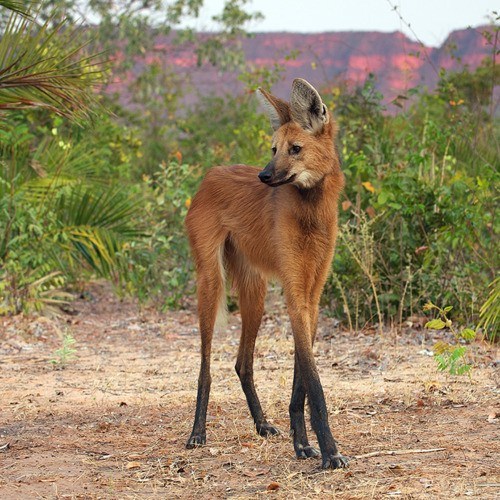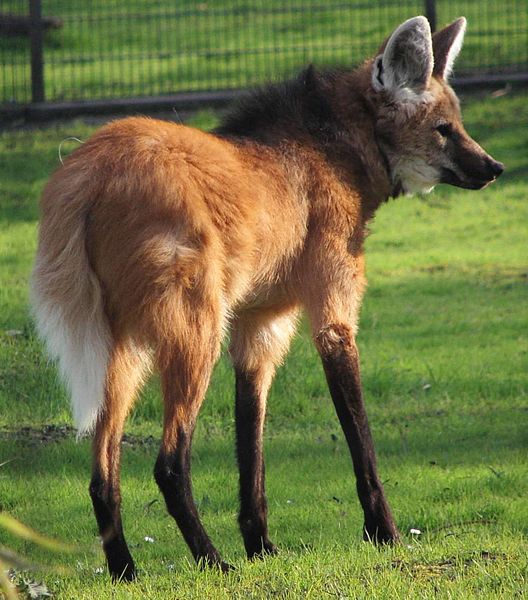Welcome to the Land of the Maned Wolf!

Image Courtesy to Scottie Westfall
What has the long legs of a giraffe, the mane of a horse, the paws of a wolf, the head of a fox, and smells like a skunk? You got it! The species Chrysocyon brachyurus!
Believe it or not, South America’s largest wild canine is neither a member of the fox or wolf species! Rather, it is called the maned wolf, which is a single existing species within a single genus Chrysocyon brachyurus (graywolfconservation.com). Standing up to 3 feet in height and measuring 4 feet long, the Chrysocyon brachyurus is the largest dog-like animal in South America and is one of the larger beasts of the wolf kind (cosmosmith.com). The animal may appear to weigh a lot because of it's incredible size; however, the maned wolf rarely weighs over fifty pounds (Dietz 1985).
 This enormous and
unbelievably graceful dog-like organism has the common name “maned wolf.”
This common name is based on the maned wolf’s unique black mane that is made up of of 5 to 6 inch long
stiff hairs, which can be erected along the back when it scents
danger (retrieverman.net). The body is covered with thick, long,
shaggy, and bright, reddish-brown hair, with black covering the
mane, muzzle, lower limbs, and anterior part of the dorsal erectile
mane. White markings are on the inner ear, throat, and tip of the
distinctive long bushy tail. With a slender muzzle, large triangular
ears, and a big nose, the maned wolf's head is very similar to that
of the fox (Dietz 1985). Because of the organism's reddish
fur, similar appearance to a fox, and very long legs, the maned wolf
has also established the nickname "red fox on stilts" (graywolfconservation.com).
This enormous and
unbelievably graceful dog-like organism has the common name “maned wolf.”
This common name is based on the maned wolf’s unique black mane that is made up of of 5 to 6 inch long
stiff hairs, which can be erected along the back when it scents
danger (retrieverman.net). The body is covered with thick, long,
shaggy, and bright, reddish-brown hair, with black covering the
mane, muzzle, lower limbs, and anterior part of the dorsal erectile
mane. White markings are on the inner ear, throat, and tip of the
distinctive long bushy tail. With a slender muzzle, large triangular
ears, and a big nose, the maned wolf's head is very similar to that
of the fox (Dietz 1985). Because of the organism's reddish
fur, similar appearance to a fox, and very long legs, the maned wolf
has also established the nickname "red fox on stilts" (graywolfconservation.com).
The height of the maned wolf was adapted to help the animal see over the tall grasslands it inhabits (Go to Habitat) and also hunt for prey (cosmosmith.com). This nocturnal animal is characterized by hunting for small prey, and they do so by following the small vertebrates through the grass and then pouncing on it, catching it with the front claws (nationalzoo.si.edu). They also feed on fruit, birds, and sugarcane (graywolfconservation.com). (Go to Nutrition)
To go along with the maned wolf's unique unwolf-like appearance, the animal also acts very strange. Unlike true wolves, maned wolves prefer to live solitary lives and are characterized by mutual avoidance. They do not live nor hunt in packs like true wolves do. Males and females form a life-long relationship with only one partner, and the monogamous pairs share a permanent defended territory that is about the size of 27 km; however, the monogamous pair only interact during the breeding season (nationalzoo.si.edu). (Go to Reproduction) Maned wolves produce signals that can be sensed over very long distances, which in turn could be related to the spacing and avoidance between the organisms. Some of these signals include barking, visual displays, and specific location of defecation (Dietz 1985). The organism is also unique by rarely having vocalization and scent markings, and the urine of the maned wolf has a very pungent skunk odor to it (Dietz 1984). (Go to Facts)
Maned wolves are extremely shy and cautious, which makes it hard to observe them in nature and causes a lot of unknown information about their life history. From what has been researched, studied, and published on the organism's habits and lifestyle, I have combined some valuable information. So if you would like to learn more, explore the rest of my site and indulge into the world of the maned wolf! Or if this fascinating animal isn’t what you’re looking for, here is a link to MultipleOrgansims.net, a place to find tons of information to expand your knowledge about the diverse organisms around you!
Read on about the Classification of Chrysocyon brachyurus.
Visit my school's website at
www.uwlax.edu
